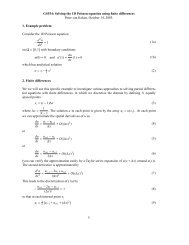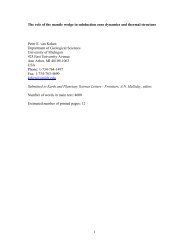Quantitative paleoenvironmental and paleoclimatic reconstruction ...
Quantitative paleoenvironmental and paleoclimatic reconstruction ...
Quantitative paleoenvironmental and paleoclimatic reconstruction ...
You also want an ePaper? Increase the reach of your titles
YUMPU automatically turns print PDFs into web optimized ePapers that Google loves.
ARTICLE IN PRESS<br />
38 N.D. Sheldon, N.J. Tabor / Earth-Science Reviews xxx (2009) xxx–xxx<br />
hydrogen isotope exchange does not seem to adequately explain the<br />
origin <strong>and</strong> isotope composition of these kaolinites. Uysal et al. (2000)<br />
suggested that the δ 18 O <strong>and</strong> δD values of phyllosilicate from<br />
the Permian coal measures in Australia result from hydrothermal<br />
(~235 °C), rock-dominated, alteration during Late Triassic tectonic<br />
extension, <strong>and</strong> are not related to pedogenesis. The conclusions of<br />
Uysal et al. (2000) are significant because, if correct, post-formational<br />
change of hydrogen isotopes, in the absence of dissolution (<strong>and</strong> a<br />
corresponding change in δ 18 O values), has yet to be demonstrated as<br />
an important process in hydroxylated pedogenic minerals (Yeh <strong>and</strong><br />
Savin, 1977; Yeh <strong>and</strong> Epstein, 1978; Elsinger <strong>and</strong> Ye, 1981; Yapp, 1993a,<br />
2000; Sheppard <strong>and</strong> Gilg, 1996; Gilg, 2000; Tabor <strong>and</strong> Montañez,<br />
2005; Tabor, 2007; cf. O'Neil <strong>and</strong> Kharaka, 1976; Keyser <strong>and</strong> Kerrich,<br />
1991).<br />
At higher-resolution scales, Stern <strong>and</strong> others (1997) noted a 3–4‰<br />
increase in δ 18 O values of mixed smectite <strong>and</strong> kaolinite samples from<br />
Miocene paleosol profiles, over a 1–2 My interval (~8.5–6.5 Ma), in<br />
the Himalayan Molasse of Pakistan. These workers attributed the shift<br />
in phyllosilicate δ 18 O values to be mechanistically linked to the onset<br />
of Indian Monsoon atmospheric circulation, <strong>and</strong> to diversion of<br />
isotopically heavier moisture over the Indian Ocean to interior<br />
continental sites (see also Quade et al., 1989, 1995; DeCelles et al.,<br />
2007). In their study of mixed 2:1 <strong>and</strong> 1:1 phyllosilicates from Permo-<br />
Carboniferous paleosols of the southwestern U.S.A., Tabor et al. (2002)<br />
noted that paleosol phyllosilicates record δ 18 O values similar to those<br />
found in modern low-latitude, coastal <strong>and</strong> maritime sites. Tabor <strong>and</strong><br />
Montañez (2002) interpreted these results to indicate a western<br />
source of meteoric precipitation, <strong>and</strong> low-latitude, reverse equatorial<br />
flow over western equatorial Pangea.<br />
Several studies have used both δD <strong>and</strong> δ 18 O values of hydroxylated<br />
minerals as monitors of paleo-elevation (Chamberlain <strong>and</strong> Poage,<br />
2000; Horton et al., 2004). Chamberlain <strong>and</strong> Poage (2000) noted an<br />
~6‰ decrease in Early Pliocene smectites from altered ashes in New<br />
Zeal<strong>and</strong>, which they attributed to an ~2 km uplift of the Southern Alps.<br />
δD values of Eocene-age kaolinites that formed by alteration of<br />
auriferous gravels in California, U.S.A., indicate that the Sierra Nevada<br />
Range has remained high (N2200 m) over the past 40 to 50 million<br />
years (Mulch <strong>and</strong> Chamberlain, 2006). These studies are based upon<br />
the assumption that hydroxylated mineral δ 18 O <strong>and</strong> δD values change<br />
with elevation. In their survey of 68 studies of meteoric waters in<br />
mountain belts, Poage <strong>and</strong> Chamberlain (2001) found that meteoric<br />
water δ 18 O values decrease by 2.8‰ for every kilometer of elevation<br />
rise (R 2 =0.79). As with other paleoelevation methods (e.g., Quade<br />
et al., 2007; Rowley <strong>and</strong> Garzione, 2007), the choice of lapse rate<br />
model greatly affects the absolute elevations predicted using pedogenic<br />
δ 18 O values.<br />
7.5.3. Single-mineral paleotemperature estimates<br />
The potential of pedogenically-formed hydroxylated minerals as<br />
single-mineral geothermometers has been realized since pioneering<br />
studies of phyllosilicate δ 18 O <strong>and</strong> δD values in soils <strong>and</strong> sediments in<br />
the early 1970 s (Savin <strong>and</strong> Epstein, 1970a,b; Lawrence <strong>and</strong> Taylor,<br />
1971; Lawrence <strong>and</strong> Taylor, 1972). These early studies determined that<br />
δ 18 O <strong>and</strong> δD values of soil-formed <strong>and</strong> other “supergene” hydroxylated<br />
minerals define an array that is roughly parallel with the meteoric<br />
water line. Savin <strong>and</strong> Epstein (1970a) suggested that, under conditions<br />
of chemical equilibrium with meteoric water, hydroxylated mineral<br />
δ 18 O <strong>and</strong> δD values exhibit the following general relation:<br />
" #<br />
"" #<br />
#<br />
D α<br />
δD m =8 m−w<br />
δ 18 D α<br />
O m + 1000 8 × m−w<br />
− 6:99 D α m−w − 1<br />
18 α m−w<br />
18 α m−w<br />
ð57Þ<br />
Subscript “m” denotes the mineral of interest, <strong>and</strong> the terms D α m-w<br />
<strong>and</strong> 18 α m-w denote the hydrogen <strong>and</strong> oxygen isotope fractionation<br />
values (α-values), respectively, between the mineral of interest <strong>and</strong><br />
water. Given that values for D α m-w <strong>and</strong> 18 α m-w are temperature<br />
dependent (Table 5), <strong>and</strong> provided that temperature-dependent fractionation<br />
factors are known, these early studies speculated that measurements<br />
of δD m <strong>and</strong> δ 18 O m in soil-formed hydroxylated minerals<br />
might provide information about the temperature of crystallization.<br />
7.5.3.1. Goethite. Yapp (1987a,b, 1993a, 2000) suggested that<br />
measured δ 18 O <strong>and</strong> δD values of ancient goethites might be useful as<br />
single-mineral paleothermometers. This paleotemperature proxy<br />
assumes chemical equilibrium with waters that lie upon Craig's<br />
(1961) Meteoric Water Line:<br />
○<br />
T<br />
ð KÞ = 1:63×10 6 !1<br />
2<br />
Δ 18 O g−w +12:3<br />
where,<br />
Δ 18 O g−w = δ 18 O g − δ 18 O w ≈10 3 ln 18 α g−w<br />
<strong>and</strong><br />
2<br />
ð<br />
δ 18 6<br />
O w = 4<br />
1000 + δD g<br />
D α<br />
ð58Þ<br />
ð59Þ<br />
3<br />
Þ<br />
− 1010<br />
7<br />
5 ð60Þ<br />
8<br />
δD g <strong>and</strong> δ 18 O g are the measured hydrogen <strong>and</strong> oxygen isotope<br />
composition, respectively, of goethite, <strong>and</strong> D α g-w is the stable<br />
hydrogen isotope fractionation factor between goethite <strong>and</strong> water<br />
(0.905; see Table 5). The analytical uncertainty of paletemperature<br />
estimates using this method is no better than ±3 °C. Using this<br />
approach, Yapp (2000) presented δD g <strong>and</strong> δ 18 O g values of 31 different<br />
natural goethite samples. The goethite δD g <strong>and</strong> δ 18 O g values<br />
corresponded to a range of crystallization temperatures from 6° to<br />
69 °C, of which 16 goethites plotted within the goethite Modern<br />
Surface Domain, 8 goethites plotted within the limits of the goethite<br />
Warm Earth Surface Domain, <strong>and</strong> 7 goethites occurred outside the<br />
limits of either goethite surface domain. Tabor <strong>and</strong> others (2004a)<br />
measured δD g <strong>and</strong> δ 18 O g values of −132 ± 4‰ <strong>and</strong> 2.7±0.2‰,<br />
respectively, for goethite from a paleosol in Argentina that formed<br />
during the Late Triassic, at ~35–40° S paleolatitude. These values<br />
correspond to a crystallization temperature of 6±3 °C; relatively cool<br />
temperatures for an interval of time that is generally associated with a<br />
Greenhouse (warm) global climate. Pleistocene-age goethites from<br />
Oklahoma, U.S.A., preserve δD g <strong>and</strong> δ 18 O g values of ~−123 ± 3‰ <strong>and</strong><br />
~2.9±0.2‰, values which correspond to crystallization temperatures<br />
of ~9±3 °C (Tabor <strong>and</strong> Yapp, 2005c). Such inferred paleotemperatures<br />
are 7 °C lower than modern mean annual temperatures in<br />
Oklahoma, U.S.A., <strong>and</strong> correspond well with independent studies that<br />
propose temperatures were ~6 °C cooler in this region during intervals<br />
of Pleistocene time (Stute et al., 1992; Stute <strong>and</strong> Schlosser, 1993).<br />
7.5.3.2. Smectite <strong>and</strong> mixed phyllosilicates. Delgado <strong>and</strong> Reyes (1996)<br />
used oxygen (Savin <strong>and</strong> Lee, 1988) <strong>and</strong> hydrogen (Capuano, 1992)<br />
isotope fractionation equations for smectite, in conjunction with<br />
Craig's (1961) equation for the Meteoric Water Line in order to relate<br />
the δ 18 O <strong>and</strong> δD values of smectite in paleosols to temperature of<br />
crystallization:<br />
○<br />
T<br />
ð KÞ = 3:54×10 6 !1<br />
2<br />
δ 18 O sm −0:125δD sm +8:95<br />
ð0 − 150 ○ CÞ ð61Þ<br />
where δ 18 O sm <strong>and</strong> δD sm are the measured smectite δ 18 O <strong>and</strong> δD values.<br />
The analytical uncertainty of paleotemperature estimates using<br />
this method is no better than ±3 °C. Delgado <strong>and</strong> Reyes observed that<br />
Please cite this article as: Sheldon, N.D., Tabor, N.J., <strong>Quantitative</strong> <strong>paleoenvironmental</strong> <strong>and</strong> <strong>paleoclimatic</strong> <strong>reconstruction</strong> using paleosols, Earth-<br />
Science Reviews (2009), doi:10.1016/j.earscirev.2009.03.004















